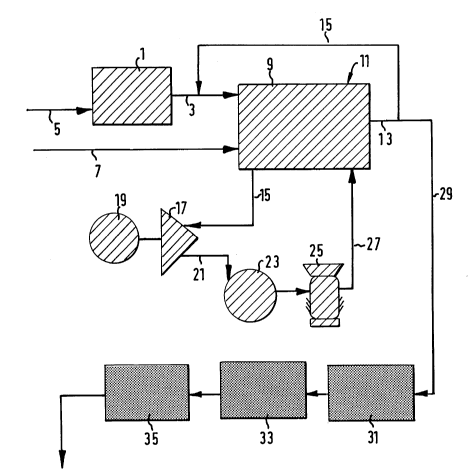Une partie des informations de ce site Web a été fournie par des sources externes. Le gouvernement du Canada n'assume aucune responsabilité concernant la précision, l'actualité ou la fiabilité des informations fournies par les sources externes. Les utilisateurs qui désirent employer cette information devraient consulter directement la source des informations. Le contenu fourni par les sources externes n'est pas assujetti aux exigences sur les langues officielles, la protection des renseignements personnels et l'accessibilité.
L'apparition de différences dans le texte et l'image des Revendications et de l'Abrégé dépend du moment auquel le document est publié. Les textes des Revendications et de l'Abrégé sont affichés :
| (12) Demande de brevet: | (11) CA 2018266 |
|---|---|
| (54) Titre français: | METHODE DE PRODUCTION D'ENERGIE ET DE GAZ CARBONIQUE |
| (54) Titre anglais: | METHOD TO PRODUCE ENERGY AND CARBON DIOXIDE |
| Statut: | Morte |
| (52) Classification canadienne des brevets (CCB): |
|
|---|---|
| (51) Classification internationale des brevets (CIB): |
|
| (72) Inventeurs : |
|
| (73) Titulaires : |
|
| (71) Demandeurs : | |
| (74) Agent: | SMART & BIGGAR |
| (74) Co-agent: | |
| (45) Délivré: | |
| (22) Date de dépôt: | 1990-06-05 |
| (41) Mise à la disponibilité du public: | 1991-12-05 |
| Requête d'examen: | 1997-04-23 |
| Licence disponible: | S.O. |
| (25) Langue des documents déposés: | Anglais |
| Traité de coopération en matière de brevets (PCT): | Non |
|---|
| (30) Données de priorité de la demande: | S.O. |
|---|
T 6023 CAN
A B S T R A C T
METHOD TO PRODUCE ENERGY AND CARBON DIOXIDE
A method to produce energy and carbon dioxide, comprising
introducing a stream of essentially oxygen and a stream of
hydrocarbon fuel into a combustion chamber, combusting the
hydrocarbon fuel with the oxygen in the combustion chamber thereby
producing an amount of energy and a stream of combustion gas
comprising carbon dioxide, and using at least a first part of said
amount of energy to drive a turbine thereby generating mechanical
energy. At least a first part of the stream of combustion gas is
cooled and recycled into the combustion chamber so as attenuate the
combustion temperature in said chamber.
CS7.T6023PD
Note : Les revendications sont présentées dans la langue officielle dans laquelle elles ont été soumises.
Note : Les descriptions sont présentées dans la langue officielle dans laquelle elles ont été soumises.

Pour une meilleure compréhension de l'état de la demande ou brevet qui figure sur cette page, la rubrique Mise en garde , et les descriptions de Brevet , États administratifs , Taxes périodiques et Historique des paiements devraient être consultées.
| Titre | Date |
|---|---|
| Date de délivrance prévu | Non disponible |
| (22) Dépôt | 1990-06-05 |
| (41) Mise à la disponibilité du public | 1991-12-05 |
| Requête d'examen | 1997-04-23 |
| Demande morte | 1999-06-07 |
| Date d'abandonnement | Raison | Reinstatement Date |
|---|---|---|
| 1998-06-05 | Taxe périodique sur la demande impayée |
| Type de taxes | Anniversaire | Échéance | Montant payé | Date payée |
|---|---|---|---|---|
| Le dépôt d'une demande de brevet | 0,00 $ | 1990-06-05 | ||
| Enregistrement de documents | 0,00 $ | 1990-11-09 | ||
| Taxe de maintien en état - Demande - nouvelle loi | 2 | 1992-06-05 | 100,00 $ | 1992-05-05 |
| Taxe de maintien en état - Demande - nouvelle loi | 3 | 1993-06-07 | 100,00 $ | 1993-05-03 |
| Taxe de maintien en état - Demande - nouvelle loi | 4 | 1994-06-06 | 100,00 $ | 1994-05-03 |
| Taxe de maintien en état - Demande - nouvelle loi | 5 | 1995-06-05 | 150,00 $ | 1995-05-01 |
| Taxe de maintien en état - Demande - nouvelle loi | 6 | 1996-06-05 | 150,00 $ | 1996-05-08 |
| Requête d'examen | 400,00 $ | 1997-04-23 | ||
| Taxe de maintien en état - Demande - nouvelle loi | 7 | 1997-06-05 | 150,00 $ | 1997-05-09 |
Les titulaires actuels et antérieures au dossier sont affichés en ordre alphabétique.
| Titulaires actuels au dossier |
|---|
| SHELL CANADA LIMITED |
| Titulaires antérieures au dossier |
|---|
| ESLINGER, KEITH MERLIN |
| KAUFMAN, STEPHEN ALLEN |